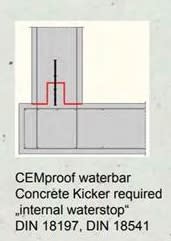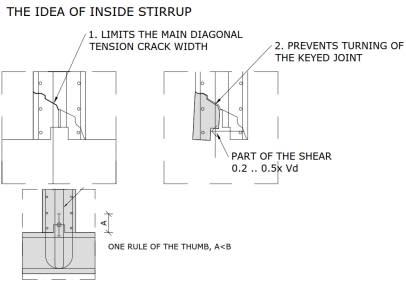PeterJ1982
Structural
- Jun 7, 2010
- 7
Hi all.
As we know, pvc-p waterstops are good for watertightness. So we use them constantly with partial kickers so that the waterstop can be assembled. The problem is, PVC-P has a really much lower E than concrete. What really happens when adding the pcv-p inside concrete? It will create a hole to the section, and you can simulate it with an empty space inside the wall. Manufacturers tries to sell quite wide waterstops and I have heard some dimension instructions like this :" waterbar should be as wide as a wall". The quite ultimate case example is in one big waterbar company prochure here:

About 10 years ago I saw somebody added rebars both side to the waterstop. I thought that the reason was cold-joint shear dowelling, but now I think it might have been for the hole as well. Some discussion would be nice to have.

I am quite sure that inside stirrups help the situation because they limit the diagonal crack width and also, if shear wants to go to the kicker in tension side, inside stirrup keeps the concrete block under the main diagonal tension crack at place.

Also I think that we are somehow safe if and only if we have enough tension reinforcement so that it's tension is far under yielding stress in ULS. Also we are safer if there is compression reinforcement.
I would like to get better knowledge about several things:
- Does anybody have had real life issues with the problem I have described?
- I am completely sure that there is some limit how up that hole can rise without limiting the capacity at least without some extra bars. Is it safe enought to use a limit A<B in the picture?
- Of course ultimate solution would be using diagonal stirrups, but they are not so easy to assemble than vertical ones..
- I am also sure that the inside stirrup helps. Does those inside stirrups help a lot or only a little?
- What will be the effect of the amount of compression reinforcement to the capacity issue? I mean, basic truss analogy formulation gives us both compression and horizontal force in the base slab junction at the compression steel. Can we use compression steel dowel action if and only if there is quite much of a steel (because of backfill)?
As we know, pvc-p waterstops are good for watertightness. So we use them constantly with partial kickers so that the waterstop can be assembled. The problem is, PVC-P has a really much lower E than concrete. What really happens when adding the pcv-p inside concrete? It will create a hole to the section, and you can simulate it with an empty space inside the wall. Manufacturers tries to sell quite wide waterstops and I have heard some dimension instructions like this :" waterbar should be as wide as a wall". The quite ultimate case example is in one big waterbar company prochure here:

About 10 years ago I saw somebody added rebars both side to the waterstop. I thought that the reason was cold-joint shear dowelling, but now I think it might have been for the hole as well. Some discussion would be nice to have.

I am quite sure that inside stirrups help the situation because they limit the diagonal crack width and also, if shear wants to go to the kicker in tension side, inside stirrup keeps the concrete block under the main diagonal tension crack at place.

Also I think that we are somehow safe if and only if we have enough tension reinforcement so that it's tension is far under yielding stress in ULS. Also we are safer if there is compression reinforcement.
I would like to get better knowledge about several things:
- Does anybody have had real life issues with the problem I have described?
- I am completely sure that there is some limit how up that hole can rise without limiting the capacity at least without some extra bars. Is it safe enought to use a limit A<B in the picture?
- Of course ultimate solution would be using diagonal stirrups, but they are not so easy to assemble than vertical ones..
- I am also sure that the inside stirrup helps. Does those inside stirrups help a lot or only a little?
- What will be the effect of the amount of compression reinforcement to the capacity issue? I mean, basic truss analogy formulation gives us both compression and horizontal force in the base slab junction at the compression steel. Can we use compression steel dowel action if and only if there is quite much of a steel (because of backfill)?
